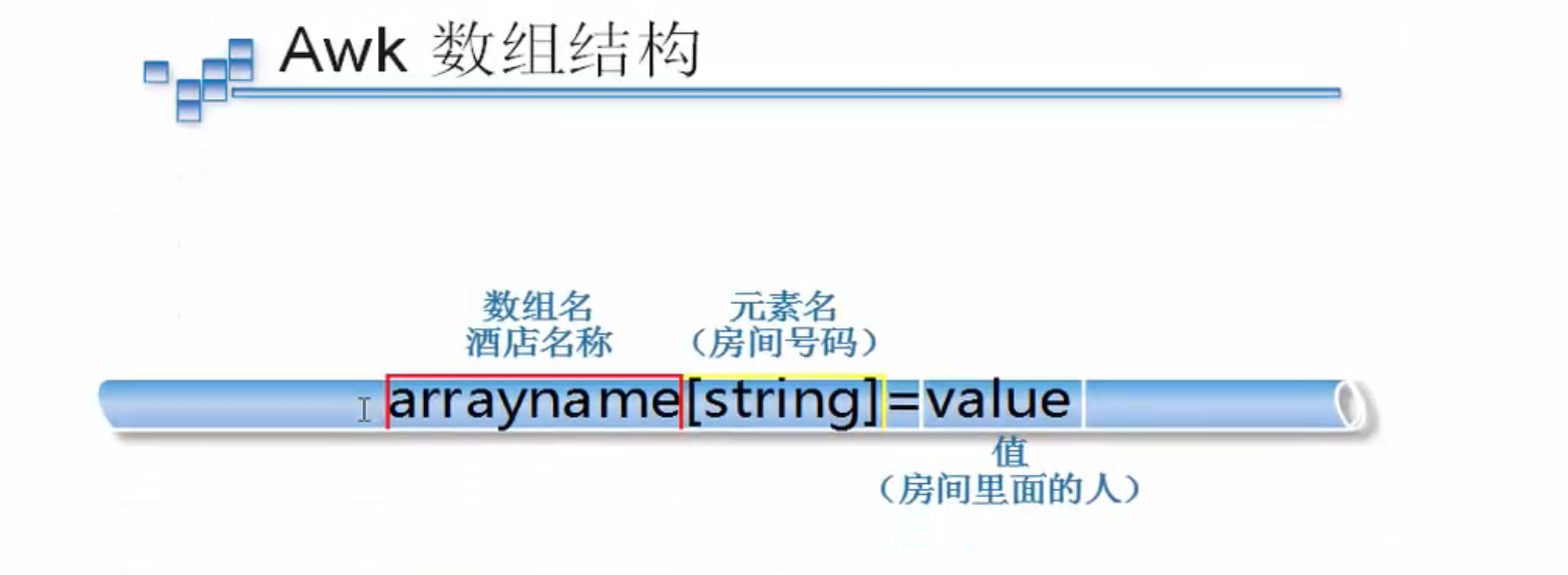Shell编程(week4_day5)--技术流ken
本节内容
1. 三剑客简介
2. sed命令详解
3. awk命令详解
文本处理三剑客
在 Shell 下使用这些正则表达式处理文本最多的命令有下面几个工具:
|
命令 |
描述 |
|
grep |
默认不支持扩展表达式,加-E 选项开启 ERE。如果不加-E 使用花括号要加转义符\{\} |
|
egrep |
支持基础和扩展表达式 |
|
awk |
支持 egrep 所有的正则表达式 |
|
sed |
默认不支持扩展表达式,加-r 选项开启 ERE。如果不加-r 使用花括号要加转义符\{\}
|
sed详解
1. 前言
-
我们都知道,在Linux中一切皆文件,比如配置文件,日志文件,启动文件等等。如果我们相对这些文件进行一些编辑查询等操作时,我们可能会想到一些vi,vim,cat,more等命令。但是这些命令效率不高,而在linux中有三种工具:顶配awk,中配sed,标配grep。使用这些工具,我们能够在达到同样效果的前提下节省大量的重复性工作,提高效率。
-
文件内容可以是来自文件,也可以直接来自键盘或者管道等标准输入,最后的结果默认情况下是显示到终端的屏幕上,但是也可以输出到文件中。
-
编辑文件也是这样,以前我们修改一个配置文件,需要移动光标到某一行,然后添加点文字,然后又移动光标到另一行,注释点东西.......可能修改一个配置文件下来需要花费数十分钟,还有可能改错了配置文件,又得返工。这还是一个配置文件,如果数十个数百个呢?因此当你学会了sed命令,你会发现利用它处理文件中的一系列修改是很有用的。只要想到在大约100多个文件中,处理20个不同的编辑操作可以在几分钟之内完成,你就会知道sed的强大了。
2. 语法格式
sed [选项] [sed命令] [输入文件]
说明:
1,注意sed软件以及后面选项,sed命令和输入文件,每个元素之间都至少有一个空格。
2,sed -commands(sed命令)是sed软件内置的一些命令选项,为了和前面的options(选项)区分,故称为sed命令
3,sed -commands 既可以是单个sed命令,也可以是多个sed命令组合。
4,input -file (输入文件)是可选项,sed还能够从标准输入如管道获取输入。
3. sed的工作原理
sed读取一行,首先将这行放入到缓存中
然后,才对这行进行处理
处理完成以后,将缓冲区的内容发送到终端
存储sed读取到的内容的缓存区空间称之为:模式空间(Pattern Space)
4. 选项说明
| option[选项] |
解释说明(带*的为重点) |
|---|---|
|
-n (no) |
取消默认的sed软件的输出,常与sed命令的p连用。* |
|
-e (entry) |
一行命令语句可以执行多条sed命令 * |
|
-r (ruguler) |
使用扩展正则表达式,默认情况sed只识别基本正则表达式 * |
|
-i (inside) |
直接修改文件内容,而不是输出到终端,如果不使用-i选项sed软件只是修改在内存中的数据,并不会影响磁盘上的文件* |
| sed -commands[sed命令] |
解释说明(带*的为重点) |
|---|---|
|
a (append) |
|
|
c (change) |
取代指定的行 |
|
d (delete) |
删除指定的行 * |
|
i (insert) |
插入,在指定行前添加一行或多行文本 * |
|
p (print) |
|
| 特殊符号 |
解释说明(带*的为重点) |
|---|---|
|
! |
|
sed增删改查
1. 增
这里我们需要用到2个sed命令,分别是:
- “a”:追加文本到指定行后,记忆方法:a的全拼是apend,意思是追加。
- “i“:插入文本到指定行前,记忆方法:i的全拼是insert,意思是插入。
实例1:a
[root@ken ~]# sed "2a 这是新添加的一行" test this is the first line this is the second line 这是新添加的一行 this is the third line this is the forth line this is the fivth line this is the sixth line this is the seventh line this is the eighth line this is the ninth line this is the tenth line
- 2代表指定对第2行操作,其他的行忽略
- a代表插入的意思,2i即在第2行前插入文本
- 2a后面加上空格,然后跟上你想要插入的文本即可
实例2:i
[root@ken ~]# sed "2i 我又新添加了一行" test this is the first line 我又新添加了一行 this is the second line this is the third line this is the forth line this is the fivth line this is the sixth line this is the seventh line this is the eighth line this is the ninth line this is the tenth line
实例3:同时增加多行(/n)
[root@ken ~]# sed "2i 这是第一条记录\n这是第二条记录\n这是第三条记录" test this is the first line 这是第一条记录 这是第二条记录 这是第三条记录 this is the second line this is the third line this is the forth line this is the fivth line this is the sixth line this is the seventh line this is the eighth line this is the ninth line this is the tenth line
2.删
- 这个功能也是非常得有用,比如我们想删除文件中的某些行,以前最常用的是vi或vim命令,但现在我们知道了sed命令,就应该使用这个高逼格的命令完成任务了。
- “d”:删除文本,记忆方法:d的全拼是delete,意思是删除。
- sed软件可以对单行或多行文本进行处理。如果在sed命令前面不指定地址范围,那么默认会匹配所有行。
实例1:删除所有的行
[root@ken ~]# cp test{,.bak} [root@ken ~]# sed 'd' test
命令说明:如果在sed命令前面不指定地址范围,那么默认会匹配所有行,然后使用d命令删除功能就会删除这个文件的所有内容
实例2:删除指定的行
[root@ken ~]# cat test.bak >test [root@ken ~]# sed '2d' test this is the first line this is the third line this is the forth line this is the fivth line this is the sixth line this is the seventh line this is the eighth line this is the ninth line this is the tenth line
实例3:删除指定范围行
[root@ken ~]# sed '2,5d' test this is the first line this is the sixth line this is the seventh line this is the eighth line this is the ninth line this is the tenth line
实例4:删除匹配的行
[root@ken ~]# sed '/sixth/d' test this is the first line this is the second line this is the third line this is the forth line this is the fivth line this is the seventh line this is the eighth line this is the ninth line this is the tenth line
命令说明:在sed软件中,使用正则的格式和awk一样,使用2个”/“包含指定的正则表达式,即“/正则表达式/”。
实例5:删除指定行到行尾的内容
[root@ken ~]# sed '2,$d' test this is the first line
第二行也会被删掉
实例6:取反
一、
[root@ken ~]# sed '2,3!d' test this is the second line this is the third line
二、
[root@ken ~]# sed '/tenth/!d' test this is the tenth line
3.改
- “c”:用新行取代旧行,记忆方法:c的全拼是change,意思是替换。
[root@ken ~]# sed '2c 改过之后的第二行' test this is the first line 改过之后的第二行 this is the third line this is the forth line this is the fivth line this is the sixth line this is the seventh line this is the eighth line this is the ninth line this is the tenth line this is sixth line
文本替换
- 接下来说的这个功能,有工作经验的同学应该非常的熟悉,因为使用sed软件80%的场景就是使用替换功能。
- 这里用到的sed命令,选项:
“s”:单独使用-->将每一行中第一处匹配的字符串进行替换==>sed命令
“g”:每一行进行全部替换-->sed命令s的替换标志之一(全局替换),非sed命令。
“-i”:修改文件内容-->sed软件的选项,注意和sed命令i区别。
sed软件替换模型
sed -i 's/目标内容/替换内容/g' ken.log
sed -i 's#目标内容#替换内容#g'
实例1:
[root@ken ~]# sed 's/line/hang/g' test this is the first hang this is the second hang this is the third hang this is the forth hang this is the fivth hang this is the sixth hang this is the seventh hang this is the eighth hang this is the ninth hang this is the tenth hang this is sixth hang
命令说明:从上面命令的结果我们就知道sed命令默认不会修改文件的内容
实例2:
[root@ken ~]# sed -i 's/line/hang/g' test [root@ken ~]# cat test this is the first hang this is the second hang this is the third hang this is the forth hang this is the fivth hang this is the sixth hang this is the seventh hang this is the eighth hang this is the ninth hang this is the tenth hang this is sixth hang
命令说明:如果想真正的修改文件内容,我们就需要使用选项“-i”,这个要和sed命令“i”区分开来。同时我们可以发现命令执行后的结果是没有任何输出的。
4.查
- 这个功能也是非常得有用,比如我们想查看文件中的某些行,以前最常用的是cat或more或less命令等,但这些命令有些缺点,就是不能查看指定的行。而我们用了很久的sed命令就有了这个功能了。而且我们前面也说过使用sed比其他命令vim等读取速度更快!
- 这里我们需要用到1个sed命令
- “p”:输出指定内容,但默认会输出2次匹配的结果,因此使用-n选项取消默认输出,记忆方法:p的全拼是print,意思是打印。
实例1:
[root@ken ~]# sed '2p' test this is the first hang this is the second hang this is the second hang this is the third hang this is the forth hang this is the fivth hang this is the sixth hang this is the seventh hang this is the eighth hang this is the ninth hang this is the tenth hang this is sixth hang [root@ken ~]# sed -n '2p' test this is the second hang
实例2:
[root@ken ~]# sed -n '2,5p' test this is the second hang this is the third hang this is the forth hang this is the fivth hang
实例3:
[root@ken ~]# sed -n '/ninth/p' test this is the ninth hang
补充:-e多点操作
实例1:
[root@ken ~]# sed -e '2d' -e '5d' test this is the first hang this is the third hang this is the forth hang this is the sixth hang this is the seventh hang this is the eighth hang this is the ninth hang this is the tenth hang this is sixth hang
实例2:
[root@ken ~]# sed -n -e '2p' -e '5p' test this is the second hang this is the fivth hang
sed用法总结
1.查找指定的字符串
例子:显示/etc/passwd中保含root的行(显示模式空间中的内容)
方法1:set '/root/p' /etc/passwd 方法2:cat /etc/passwd | sed '/root/p'
2.在指定的位置做增删
例子:删除以root为开头的行
# sed '/^root/d' a.txt
例子:在包含root的行后添加一行 i am ken
# sed '/root/a i am ken' a.txt
3.按行替换
例子:将5到9行的内容替换为 i am ken
# sed '5,9c i am ken' a.txt
4.按照字符替换
例子:将/etc/selinux/config中的SELINUX=enforcing改成 disabled
写法1:# sed -i 's/SELINUX=disabled/SELINUX=enforcing/g' config
写法2:# sed -r -i 's/(SELINUX=)disabled/\1enforcing/g' config
5.查找指定的内容再做替换
例子:将以r开头的行中的oo替换为qq
# sed '/^r/{s/oo/qq/g}' passwd
6.多点编辑
例子:去除文件中的注释行和空白行
# grep -v -E "(^#)|(^$)" passwd.bak >passwd
# cat passwd.bak | sed -e '/^#/d' -e '/^$/d' >passwd
7)取反操作
显示非1-3行
# sed -n '1,3!p' passwd
awk详解
awk不仅仅时linux系统中的一个命令,而且是一种编程语言,可以用来处理数据和生成报告(excel)。处理的数据可以是一个或多个文件,可以是来自标准输入,也可以通过管道获取标准输入,awk可以在命令行上直接编辑命令进行操作,也可以编写成awk程序来进行更为复杂的运用。
awk的格式
- awk指令是由模式,动作,或者模式和动作的组合组成。
- 模式既pattern,可以类似理解成sed的模式匹配,可以由表达式组成,也可以是两个正斜杠之间的正则表达式。比如NR==1,这就是模式,可以把他理解为一个条件。
- 动作即action,是由在大括号里面的一条或多条语句组成,语句之间使用分号隔开。比如awk使用格式:

awk处理的内容可以来自标准输入(<),一个或多个文本文件或管道。

- pattern既模式,也可以理解为条件,也叫找谁,你找谁?高矮,胖瘦,男女?都是条件,既模式。
- action既动作,可以理解为干啥,找到人之后你要做什么。
模式和动作的详细介绍我们放在后面部分,现在大家先对awk结构有一个了解。
awk参数
-F:指定分隔符
几个小概念
记录(record):一行就是一个记录
分隔符(field separator):进行对记录进行切割的时候所使用的字符
字段(field):将一条记录分割成的每一段
FILENAME:当前处理文件的文件名
FS(Field Separator):字段分隔符(默认是以空格为分隔符=)
NR(Number of Rrecord):记录的编号(awk每读取一行,NR就加1==)
NF(Number of Field):字段数量(记录了当前这条记录包含多少个字段==)
ORS(Output Record Separator):指定输出记录分隔符(指定在输出结果中记录末尾是什么,默认是\n,也就是换行)
OFS(Output Field Separator):输出字段分隔符
RS:记录分隔符
输出字段的表示方式
$1 $2 ... $n 输出一个指定的字段
$NF 输出最后一个字段
$0 输出整条记录
awk执行过程
[root@ken ~]# awk 'NR>=2&&NR<=5{print $0}' /etc/passwd bin:x:1:1:bin:/bin:/sbin/nologin daemon:x:2:2:daemon:/sbin:/sbin/nologin adm:x:3:4:adm:/var/adm:/sbin/nologin lp:x:4:7:lp:/var/spool/lpd:/sbin/nologin
命令说明: 条件NR>=2,表示行号大于等于2时候,执行{print $0}显示整行。 awk是通过一行一行的处理文件,这条命令中包含模式部分(条件)和动作部分(动作),awk将处理模式(条件)指定的行
1)awk读入第一行内容
2)判断是否符合模式中的条件NR>=2
a,如果匹配则执行对应的动作{print $0}
b,如果不匹配条件,继续读取下一行
3)继续读取下一行
4)重复过程1-3,直到读取到最后一行(EOF:end of file)
准备测试文件
[root@ken ~]# head /etc/passwd > test [root@ken ~]# cat test root:x:0:0:root:/root:/bin/bash bin:x:1:1:bin:/bin:/sbin/nologin daemon:x:2:2:daemon:/sbin:/sbin/nologin adm:x:3:4:adm:/var/adm:/sbin/nologin lp:x:4:7:lp:/var/spool/lpd:/sbin/nologin sync:x:5:0:sync:/sbin:/bin/sync shutdown:x:6:0:shutdown:/sbin:/sbin/shutdown halt:x:7:0:halt:/sbin:/sbin/halt mail:x:8:12:mail:/var/spool/mail:/sbin/nologin operator:x:11:0:operator:/root:/sbin/nologin
实例1:打印行号
[root@ken ~]# awk '{print NR,$0}' test 1 root:x:0:0:root:/root:/bin/bash 2 bin:x:1:1:bin:/bin:/sbin/nologin 3 daemon:x:2:2:daemon:/sbin:/sbin/nologin 4 adm:x:3:4:adm:/var/adm:/sbin/nologin 5 lp:x:4:7:lp:/var/spool/lpd:/sbin/nologin 6 sync:x:5:0:sync:/sbin:/bin/sync 7 shutdown:x:6:0:shutdown:/sbin:/sbin/shutdown 8 halt:x:7:0:halt:/sbin:/sbin/halt 9 mail:x:8:12:mail:/var/spool/mail:/sbin/nologin 10 operator:x:11:0:operator:/root:/sbin/nologin
实例2:输出有多余5个字段的行的第三个字段
[root@ken ~]# awk -F ':' 'NF>=5{print $3}' test 0 1 2 3 4 5 6 7 8 11
实例3:输出每行行号和该行有几个字段
[root@ken ~]# awk -F ':' '{print NR,NF}' test 1 7 2 7 3 7 4 7 5 7 6 7 7 7 8 7 9 7 10 7
awk进阶--正则
- 正则表达式的运用,默认是在行内查找匹配的字符串,若有匹配则执行action操作,但是有时候仅需要固定的列来匹配指定的正则表达式,比如:我想取/etc/passwd文件中第五列{$5}这一列查找匹配mail字符串的行,这样就需要用另外两个匹配操作符,并且awk里面只有这两个操作符来匹配正则表达式。
实例1:匹配整行
[root@ken ~]# awk '/^root/' test root:x:0:0:root:/root:/bin/bash
和下面的效果是一样的
[root@ken ~]# awk '$0~/^root/' test root:x:0:0:root:/root:/bin/bash
注意:awk只用正则表达式的时候是默认匹配整行的即‘$0~/^root/’和‘/^root/’是一样的。
实例2:匹配一行中的某一列
[root@ken ~]# awk -F ':' '$5~/root/' test root:x:0:0:root:/root:/bin/bash
提示:
- $5表示第五个区域(列)
- ~表示匹配(正则表达式匹配)
- /root/表示匹配root这个字符串
$5~/root/表示第五个区域(列)匹配正则表达式/root/,既第5列包含root这个字符串,则显示这一行。
实例3:匹配行尾为sync
[root@ken ~]# awk -F ':' '/sync$/{print $0}' test sync:x:5:0:sync:/sbin:/bin/sync
实例4:显示名字和登录类型
[root@ken ~]# awk -F ':' '{print $1,$NF}' test root /bin/bash bin /sbin/nologin daemon /sbin/nologin adm /sbin/nologin lp /sbin/nologin sync /bin/sync shutdown /sbin/shutdown halt /sbin/halt mail /sbin/nologin operator /sbin/nologin
$NF:表示匹配的末尾部分,这里也可以写成$7
实战: 取出网卡IP地址(企业面试题)
[root@ken ~]# ip a 1: lo: <LOOPBACK,UP,LOWER_UP> mtu 65536 qdisc noqueue state UNKNOWN group default qlen 1000 link/loopback 00:00:00:00:00:00 brd 00:00:00:00:00:00 inet 127.0.0.1/8 scope host lo valid_lft forever preferred_lft forever inet6 ::1/128 scope host valid_lft forever preferred_lft forever 2: eth0: <BROADCAST,MULTICAST,UP,LOWER_UP> mtu 1500 qdisc pfifo_fast state UNKNOWN group default qlen 1000 link/ether 00:0c:29:99:ea:a6 brd ff:ff:ff:ff:ff:ff inet 172.20.10.6/24 brd 172.20.10.255 scope global noprefixroute eth0 valid_lft forever preferred_lft forever inet6 2408:84f4:86:47e1:20c:29ff:fe99:eaa6/64 scope global mngtmpaddr dynamic valid_lft forever preferred_lft forever inet6 fe80::20c:29ff:fe99:eaa6/64 scope link valid_lft forever preferred_lft forever
第一种方法:
[root@ken ~]# ip a | awk -F ' +' 'NR==9{print $3}' | awk -F '/' '{print $1}' 172.20.10.6
第二种方法:
[root@ken ~]# ip a | grep -E '^ +.*inet\>.*' | awk -F ' +|/' 'NR==2{print $3}' 172.20.10.6
第三种方法:
[root@ken ~]# hostname -i | awk -F ' ' '{print $3}' 172.20.10.6
第四种方法:
[root@ken ~]# ip a | grep brd.*glo | awk -F ' +|/' '{print $3}' 172.20.10.6
第五种方法:
[root@ken ~]# ip a | grep "scope" | awk 'NR==3{print $0}' | awk -F "( |/)+" '{print $3}' 172.20.10.6
方法还有很多很多,大家如果对自己有高要求的话,要至少写出来十种以上的方法哦!
awk特殊模式-BEGIN模式与END模式
- BEGIN模块再awk读取文件之前就执行,一般用来定义我们的内置变量(预定义变量,eg:FS,RS)
- 需要注意的是BEGIN模式后面要接跟一个action操作块,包含在大括号内。awk必须在输入文件进行任何处理前先执行BEGIN里的动作(action)。我们可以不要任何输入文件,就可以对BEGIN模块进行测试,因为awk需要先执行完BEGIN模式,才对输入文件做处理。BEGIN模式常常被用来修改内置变量ORS,RS,FS,OFS等值。
BEGIN模块
实例1:
[root@ken ~]# ifconfig eth0 | awk -F "[ :]+" 'NR==2{print $3}' 172.20.10.6 [root@ken ~]# ifconfig eth0 | awk -F "[^0-9.]+" 'NR==2{print $2}' 172.20.10.6 #上面的也可以写成 [root@ken ~]# ifconfig eth0 | awk 'BEGIN{FS="[ :]+"}NR==2{print $3}' 172.20.10.6 [root@ken ~]# ifconfig eth0 | awk 'BEGIN{FS="[^0-9.]+"}NR==2{print $2}' 172.20.10.6
实例2:在读取文件之前,输出些提示性信息(表头)。
[root@ken ~]# awk -F ':' 'BEGIN{print "username","bash type"}{print $1,$NF}' test username bash type root /bin/bash bin /sbin/nologin daemon /sbin/nologin adm /sbin/nologin lp /sbin/nologin sync /bin/sync shutdown /sbin/shutdown halt /sbin/halt mail /sbin/nologin operator /sbin/nologin
END模块
EHD在awk读取完所有的文件的时候,再执行END模块,一般用来输出一个结果(累加,数组结果),也可以是和BEGIN模块类似的结尾标识信息
与BEGIN模式相对应的END模式,格式一样,但是END模式仅在awk处理完所有输入行后才进行处理。
实例1:
[root@ken ~]# awk -F ':' 'BEGIN{print "username","bash type"}{print $1,$NF}END{print "end of file"}' test username bash type root /bin/bash bin /sbin/nologin daemon /sbin/nologin adm /sbin/nologin lp /sbin/nologin sync /bin/sync shutdown /sbin/shutdown halt /sbin/halt mail /sbin/nologin operator /sbin/nologin end of file
实例2:统计包含root的行的数量
方法一:
[root@ken ~]# cat test | grep root| wc -l 2
方法二:
[root@ken ~]# cat test | grep -c root 2
方法三:
[root@ken ~]# cat /etc/passwd | awk 'BEGIN{i=0}/root/{i++}END{print i}' 2 [root@ken ~]# cat /etc/passwd | awk '/root/{i++}END{print i}' 2
总结awk执行过程
回顾一下awk的结构
awk -F 指定分隔符 ‘BRGIN{}END{}’,如下图

awk数组
数组构成:
数组名[元素名]=值

如图不难发现,awk数组就和酒店一样。数组的名称就像是酒店名称,数组元素名称就像酒店房间号码,每个数组元素里面的内容就像是酒店房间里面的人。
实战:统计域名出现的次数(百度和搜狐面试题)
[root@ken ~]# cat test http://www.qq.com/ken http://www.qq.com/ken http://www.qq.com/ken http://www.qq.com/ken http://www.qq.com/ken http://www.qq.com/ken http://www.qq.com/ken http://www.sina.com/ken http://www.sina.com/ken http://www.sina.com/ken http://www.sina.com/ken http://www.sina.com/ken http://www.sina.com/ken http://www.sina.com/ken http://www.sina.com/ken http://www.sina.com/ken http://www.sina.com/ken http://www.sina.com/ken http://www.sina.com/ken http://www.sina.com/ken http://www.taobao.com/ken http://www.taobao.com/ken http://www.taobao.com/ken http://www.taobao.com/ken http://www.taobao.com/ken http://www.taobao.com/ken http://www.taobao.com/ken http://www.taobao.com/ken http://www.taobao.com/ken http://www.taobao.com/ken http://www.taobao.com/ken http://www.taobao.com/ken http://www.taobao.com/ken http://www.taobao.com/ken http://www.taobao.com/ken http://www.taobao.com/ken http://www.taobao.com/ken http://www.taobao.com/ken http://www.taobao.com/ken http://www.taobao.com/ken http://www.taobao.com/ken http://www.taobao.com/ken http://www.taobao.com/ken http://www.taobao.com/ken http://www.taobao.com/ken
方法一:
[root@ken ~]# cat test | awk -F '/+' '{print $2}' | sort | uniq -c 7 www.qq.com 13 www.sina.com 25 www.taobao.com
方法二:
[root@ken ~]# cat test | awk -F '/+' '{h[$2]++}END{for (i in h) print i,h[i]}' www.sina.com 13 www.qq.com 7 www.taobao.com 25
awk用法总结
1. 结合内置变量,打印指定的几行,以及字段数量
例子;输出有多余5个字段的行的第三个字段
# cat a.sh | awk -F ":" 'NF>=5{print $3}'
例子:输出每行行号和该行有几个字段
# cat a.sh | awk -F ":" '{print NR,NF}'
例子:输出用户名,要求所有用户显示在同一行,而且用空格分隔
# cat mypwd | awk 'BEGIN{FS=":"; ORS=" "}{print $1}'
2. 结合正则来匹配一行或者某个字段
例子:输出用户名以s为开头的用户的uid
# cat mypwd | awk -F ":" '/^s/{print $}'
例子:输出第五个字段是以t为结尾的用户的姓名
# cat mypwd | awk -F ":" '$5~/t$/{print $1}'
3. 采用比较符号来进行打印指定的某些行
例子:实现仅仅输出3-5的内容,每行前面添加一个行号
# cat mypwd | awk 'NR>=3&&NR<=5{print NR,$1}'
或
# cat mypwd | awk 'NR==3,NR==5{print NR,$1}'
例子:实现仅仅输出3 和 5 和 7行的内容,每行前面添加一个行号
# cat mypwd | awk 'NR==3||NR==5||NR==7{print NR,$1}'
4. END
例子:统计mypwd中以#开头的行有多少行
# cat mypwd | awk 'BEGIN{n=0}/^#/{n+=1}END{print n}'
统计:mypwd中,以:为分隔符,字段数量在3-5的行的数目
# cat mypwd | awk 'BEGIN{FS=":"}NF>=3&&NF<=5{n+=1}END{print n}'
5. ip
例子:统计IP
[root@ken]# cat url.txt | awk -F "/+" '{urls[$2]++}END{for(key in urls)print key, urls[key]}’
www.baidu.com 12
haha.baidu.com 1
ftp.baidu.com 6
mail.baidu.com 7



 浙公网安备 33010602011771号
浙公网安备 33010602011771号